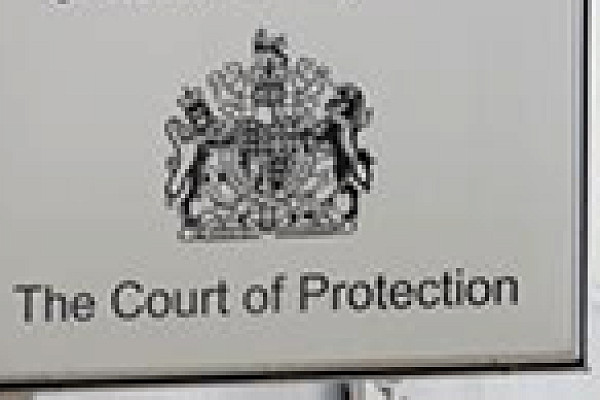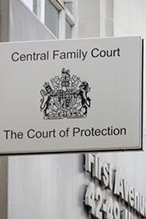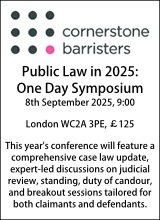
The final say
News
Must read
Families refusing access to support
Features Test

Producing robust capacity assessments and the approaches to assessing capacity

Disability discrimination and proportionality in housing management

Cross-border deprivation of liberty

Dealing with unexplained deaths and inquests

Court of Protection case update: May 2025
Features

Producing robust capacity assessments and the approaches to assessing capacity

Disability discrimination and proportionality in housing management

Cross-border deprivation of liberty

Dealing with unexplained deaths and inquests

Court of Protection case update: May 2025
Sponsored articles
What is the role of the National Trading Standards Estate & Letting Agency Team in assisting enforcement authorities?
Webinars
Is Omeprazole the new EDS?
More features
Provision of same-sex intimate care
Court of Protection case update: April 2025
High Court guidance on Article 3 engagement in care at home cases
‘Stitch’, capacity and complexity
Issuing proceedings in best interests cases
Court of Protection case law update: March 2025
The Health and Social Care (Wales) Bill Series – Regulation and Inspection of Social Care
The Health and Social Care (Wales) Bill Series – Direct Payments for NHS Continuing Healthcare
What is the right approach to Care Act assessments?
Disabled people in immigration bail: the duties of the Home Office and local authorities
Capacity, insight and professional cultures
Court of Protection update: February 2025
Setting care home fees
Could this be the end for local authority-provided residential care?
“On a DoLS”
It’s all about the care plan
Court of Protection case update: January 2025
Mental capacity and expert evidence
Best interests, wishes and feelings
Capacity, sexual relations and public protection – another go-round before the Court of Appeal
Court of Protection Update - December 2024
Fluctuating capacity, the “longitudinal approach” and practical dilemmas
Capacity and civil proceedings
Recovering adult social care charges via insolvency administration orders
Court of Protection case update: October 2024
Communication with protected parties in legal proceedings
The way forward for CQC – something old, something new….
The Ombudsman, DoLS and triaging – asking the impossible?
Outsourcing and the Human Rights Act 1998 – the consequences
Commissioning care and support in Wales: new code of practice
Court of Protection blocks council attempt to force contraception on woman with low IQ
- Details
The Court of Protection has ruled that an unnamed local authority is not able force a woman with a low IQ to use contraception, describing the plan as an “horrendous prospect [with] shades of social engineering”.
According to a report in the Times, Mr Justice Bodey said that he could not see how it could be acceptable for the court to impose contraception “by way of physical coercion”, adding that the attempt by the local authority to prevent the married woman – who has already had two children given up for adoption - having more children raised “profound questions about state intervention in private and family life”.
The council said that it brought the proceedings to enable them to physically remove the woman, who has an IQ of 53, from her family home and taken to have contraception “under restraint and anaesthesia”. It was doing so to protect her from her “violent and bullying” husband, who wanted a baby.
The judge said that while he accepted that the woman's decision to stop using contraception was not the product of her own free will, he said that he could not approve court-sanctioned coercion in this case.
He ruled: “It is obvious, on the facts of this case, that any step towards long-term court-imposed contraception by way of physical coercion, with its affinity to enforced sterilisation and shades of social engineering, would raise profound questions about state intervention in private and family life. Whilst the issue of the use of force has not been argued out at this hearing I cannot, on these facts, presently see how it could be acceptable.”
He added that if Mrs A became pregnant “so be it”. In this case, there would be an assessment of the couple and the council would have to take such steps as it thought appropriate, the Times reported.
Audit Commission disbanded after "losing its way"
- Details
The Audit Commission is to be disbanded with its auditing functions handed to the private sector and councils given the freedom to appoint their own independent external auditors, the Department for Communities and Local Government has announced.
Under the proposals:
- The Commission’s responsibilities for overseeing and delivering local audit and inspections will stop. Its research activities will also end
- A range of options will be considered for converting the Commission’s audit practice into an independent business that could compete with or be sold or transferred to the private sector
- A new decentralised audit regime will be established in the Commission’s place, and this will apply to local authorities, police authorities and local health bodies
- The powers of the Local Government Ombudsman will be strengthened to give residents greater rights when local services go wrong. The LGO’s findings will be made legally enforceable
- A statutory framework, overseen by the National Audit Office and profession, will provide protections and ensure independence, competence and quality, including audit quality
- Inspection and intervention will remain “for the most vulnerable to protect public welfare”, including children’s services and adult social care
- District auditors will retain a duty for reporting issues in the public interest. “They will be able to undertake special investigations where they, the local government sector or any continuing inspectorates such as Ofsted in the case of children's services, or Care Quality Commission on adult social care, raise concerns about a council,” the DCLG said.
The necessary legislation will be sought in this Parliamentary session, with a view to the new regime being in place by 2012/13.
The DCLG said ministers had been concerned that the Commission’s work had become less focused on accountability to citizens and more on reporting upwards to government.
Communities Secretary Eric Pickles said: “The corporate centre of the Audit Commission has lost its way. Rather than being a watchdog that champions taxpayers’ interests, it has become a creature of the Whitehall state.
“We need to redress this balance. Audit should remain to ensure taxpayers’ money is properly spent, but this can be done in a competitive environment, drawing on professional audit expertise across the country.”
He added that scrapping the Audit Commission would save the taxpayer £50m a year.
Michael O'Higgins, the Commission's chairman, said it regretted the decision but acknowledged the absolute right of the Communities Secretary to change the arrangements surrounding the architecture of government.
He insisted that it could reflect upon “the very significant successes” it had achieved during its existence. Among the successes he highlighted:
- The Commission-led investigation of the rate-capping rebellion which resulted in 32 Lambeth councillors and 47 Liverpool councillors being surcharged and banned from office
- The uncovering of the gerrymandering 'homes for votes' scandal at Westminster Council
- The corporate governance inspection of Doncaster Council in 2010 in the light of "serious concerns about the council's performance and the threat to public confidence caused by recent events", namely the brutal attack on two boys by two brothers in Edlington
- Its National Fraud Initiative, which has detected more than £200 million of fraud.
O’Higgins also argued that the Commission had played its part in assisting in the “very significant” impact of local authority improvement in the last decade. He pointed to the Decentralisation Minister Greg Clark’s comments comparing local government’s improved performance compared to central government.
The Commission’s chairman said he had taken soundings of potential purchasers of its audit practice, which had revealed significant interest in acquiring the business.
Cabinet Office unveils 12 pathfinder mutuals ahead of public sector spin-outs
- Details
A project to integrate community health and adult social services in Swindon into a co-operative is among the first wave of 12 pathfinder mutuals to get the go-ahead, the Cabinet Office has announced.
Other schemes to be selected include:
- A London-based community interest company set up by staff from the Department of Health, a local authority, a primary care trust and the NHS, and designed to reduce multiple disadvantage
- The children’s services department at the London Borough of Hammersmith and Fulham exploring new models of delivery with staff, possible commercial partners and neighbouring local authorities
- The creation of a social enterprise for delivery of housing support services to vulnerable people in Mansfield, bringing together a range of public sector workers
- The Royal Borough of Kensington and Chelsea working with employees to examine the potential for different models of employee-led youth support services
- Westminster City Council working with employees in its children’s services department and neighbouring authorities to move towards creating an arm’s length management organisation, and
- The Lambeth Resource Centre exploring options for co-producing services with employees, service users and third sector organisations to provide rehabilitation support for people with physical and sensory impairment.
The pathfinders are intended to help the government establish the type of support and structures that employee-led mutuals in the public sector will need on an ongoing basis.
The Cabinet Office said the pathfinders were exploring a variety of legal forms and methods of employee leadership. “The focus of this project is on embedding the principles of co-operation, rather than the particular legal form used to achieve this, which will be decided by each pathfinder,” it said.
The projects will also receive free assistance from “mentors” at John Lewis, PWC, KPMG, Tribal, Local Partnerships and other organisations.
Cabinet Office Minister Francis Maude said the announcement of the pathfinders was the first step in creating “a genuinely ground-up movement where staff, who are the real experts, can come together to take over and deliver better services”.
He added: “The potential for public sector staff to spin out is enormously exciting. The new models will show us how we best support mutuals, tackling problems when they first arise, not expensively managing them over many years.”
The minister claimed that the government’s Spending Challenge had unleashed “a torrent of pent up ideas and comments from public sector workers frustrated by the difficulty of implementing their suggestions”.
“If only a fraction of these 63,000 people are latent entrepreneurs, who itch to put their ideas into action, then our ambitions for public sector mutuals will be amply met,” he suggested.
Further reading: A model mutual
Detention and human rights
- Details
A man accused of harassing women he did not know has failed in his human rights challenge to his detention under the Mental Health Act 1983. Having successfully secured a writ of habeas corpus to release him from a mental health institution, he has lost his initial bid for the High Court to declare that his detention ran contrary to his human rights. He is now appealing the decision. Elspeth Wrigley looks at the case.
The case of TTM v London Borough of Hackney & Ors [2010] EWHC 1349 (Admin) has raised important questions about the extent of the ancient right of habeas corpus (relief from unlawful detention) and its interaction with the far more recent Article 5 of the European Convention on Human Rights 1950 (“ECHR”), as well as the ability of any wronged claimant to recover damages in circumstances where they are wrongly detained.
Stalking, psychosis and detention
The claimant in this case, a 27-year-old Lithuanian national, had begun harassing women he did not know. He was arrested twice in November 2008. The first time he was cautioned but on the second occasion on 13 November 2008, he was taken by the police to Homerton Hospital and admitted for assessment under s.2 of the 1983 Act. The claimant was thought to be suffering from a delusional or psychotic illness and, after several weeks at the hospital, he was detained under s. 3 of the 1983 Act on 9 December 2008.
However, TM (his brother, acting as his nearest relative) became concerned that the claimant’s treatment was inappropriate. On 16 January 2009 TM was advised of his right as the nearest relative to require the claimant’s release under s.23(2)(a) of the 1983 Act and two days later, the hospital managers received a fax from TM’s solicitors, giving notice that he intended to discharge the claimant on 22 January 2009. However, following a meeting between TM, his solicitor and the hospital staff, it was agreed that the claimant would remain in hospital. The impression was given that the claimant would remain as a voluntary patient for another two weeks, but that if he attempted to discharge himself, he should be reassessed and s.5(2) used only if there was any change in presentation.
Detention under s. 3 of the Mental Health Act 1983
Following this agreement the claimant was examined by the clinician Dr Lyall. However, his conclusion was that the claimant’s condition was serious and he should be detained under s. 3 of the 1983 Act. Although this view was shared by some of the doctors, there was no universal consensus that the claimant’s condition was serious enough to warrant sectioning. For this reason, the relevant Approved Mental Health Professional (“AMHP”) Ms Bailey, sought the advice of two independent medical advisers with a view to an application under s. 3 of the 1983 Act.
On 30 January 2009 they assessed the claimant and agreed that he should be admitted under s.3. Ms Bailey then applied to section the claimant and a number of telephone conversations followed between Ms Bailey and TM regarding his brother. There was some uncertainty as to exactly what was agreed in this calls. However, although in the second call TM said he was not agreeing to the application, Ms Bailey believed that TM expressed a later change of mind, and made the application accordingly. When it became apparent that there was a s.11(4)(a) objection to detention, the responsible clinician exercised his powers under s.25 and barred the discharge.
On 4 February 2009 an application for a writ of habeas corpus was lodged by TM and pre-action letters were sent to the defendants indicating that a judicial review claim would be made unless it was agreed that the claimant should be released from the s.3 detention. On 10 February 2009 this claim was lodged and the application heard by Burton J, as a matter of some urgency, the following day.
The writ of habeas corpus
In deciding whether to grant the remedy of habeas corpus the judge had to make the finding of fact as to whether Ms Bailey was reasonable in believing TM had changed his mind between 10.30am and 3.15pm in support of the claimant remaining in hospital.
After considering the evidence, Buxton J found that although she honestly believed that the claimant’s brother was agreeing to the sectioning, she should have in fact concluded that he was not. At paragraph 48 he summarised it thus: “… although Ms Bailey genuinely believed that there had been a change of mind by the nearest relative, it was not reasonable for her so to have believed. He was so objecting and, in those circumstances, he had given notice to her of his objection, and she had received that noticed, prior to 3.15.”
On this basis the admission under s. 3 of the 1983 Act was not lawful and the writ issued.
Buxton J was also asked to consider whether the claimant could recover damages. He did not make any finding that damages could or should always be awarded within habeas corpus proceedings and noted that the pending judicial review proceedings were the more appropriate avenue for such considerations.
Damages and judicial review
While the habeas corpus application succeeded in achieving the claimant’s release, he subsequently made an application for judicial review in which he sought a declaration that his admission to hospital under s. 3 of the 1983 Act had been unlawful. In addition, he also sought to recover damages (as required by Article 5(5) and 8 of the ECHR) and to be granted leave to pursue a claim for damages against the first defendant under s. 139(2) of the 1983 Act. Finally, the claimant also sought a declaration from the court that ss.139(1) and 6(3) of the 1983 Act were incompatible with the ECHR.
However, despite the fact that the writ for habeas corpus had been granted, the claim was dismissed on all grounds, for the reasons set out below.
The lawfulness of the s.3 admission
The claimant submitted that the s.3 admission was unlawful, as not only had TM’s objections to his brother’s detention been disregarded by the hospital managers, but neither of the two medical practitioners who recommended admission had any previous acquaintance with the claimant (in breach of s.12(2) of the 1983 Act).
The court however, did not accept these submissions. Mr Justice Collins found that the hospital managers were entitled to rely on Ms Bailey’s confirmation that there had been no objection from the nearest relative. Furthermore, the fact that neither medical practitioner knew the claimant did not make the matter unlawful. Following R (on the application of E) v Bristol City Council [2005] EWHC 74 (Admin), the decision to use two professionals who came afresh to the claimant’s case but had access to all the hospital notes and medical staff was reasonable and a proper exercise of judgment of what was in claimant’s best interests. As such there was no breach of s.12(2) and the decision was lawful in this respect.
The right to pursue damages under ss. 139(1) and (2)
Mr Justice Collins also considered whether a claim for damages should be permitted against the first defendant (the London Borough of Hackney) having regard to s.139(2) of the 1983 Act. Sections 139(1) and (1) provide:
“(1) No person shall be liable, whether on the ground of want of jurisdiction or on any other ground, to any civil proceedings to which he would have been liable apart from this section in respect of any act purporting to be done in pursuance of this Act or any regulations or rules made under this Act, unless the act was done in bad faith or without reasonable care.
(2) No civil proceedings shall be brought against any person in any court in respect of any such act without the leave of the High Court…”
Mr Justice Collins recognised that, despite acting properly, the AMPHP (Ms Bailey) was unreasonable in her belief that TM had consented to his brother’s detention. However, he found that the lawfulness of the claimant’s detention did not depend on whether the AMPHP reasonably believed that there was no objection, but whether there was an objection.
On this basis, damages should only follow if there is negligence or bad faith. Mr Justice Collins accepted Burton J’s findings that there had been none. He did note, however, that in circumstances where there had been a lack of reasonable care, there was no reason in principle why a duty of care should not exist. However, as on the facts of this case there was no reasonable prospect of success in any negligence claim, the judge declined to give leave under s. 139(2).
Damages under then Human Rights Act 1998 (“HRA 1998”)
The claimant also submitted that he should recover damages as required by Article 5(5) of the ECHR. Article 5 provides:
“5. 1. … No one shall be deprived of his liberty save in the following cases and in accordance with a procedure prescribed by law ..
(e) the lawful detention … of persons of unsound mind …
4. Everyone who is deprived of his liberty by … detention shall be entitled to take proceedings by which the lawfulness of his detention shall be decided speedily by a court and his release ordered if his detention is not lawful.
5. Everyone who has been a victim of … detention in contravention of the provisions of this article shall have an enforceable right to compensation.”
The claimant also sought to recover damages under Article 8 (right to private life) but the judge had little time for this on the basis that if the detention was lawful, there would be no breach of Article 8, and if it were not, Article 5(5) provided for an enforceable right to compensation, where Article 8 did not. He therefore proceeded to consider Article 5 alone.
In terms of the claimant’s right to damages under s.7 HRA 1998, the crucial question for the judge was whether the detention was regarded in domestic law as lawful. There was important authority supporting the view that the correct conclusion was that, absent any negligence or bad faith, the detention was to be regarded as lawful until a court decided that it was not. As it could not be shown that the claimant’s detention was unlawful in domestic law, there was no breach of Article 5 and no claim for compensation under Article 5(5) of the ECHR, therefore there could be no claim under s 7 HRA 1998.
In the light of this the judge dealt swiftly with the final point, the compatibility of s. 6 (3) and s. 139 of the 1983 Act with the HRA 1998 at paragraphs 53: “In those circumstances, there is no incompatibility in either s. 139 or s. 6(3). Provided that there has been no fault by anyone involved in the decision making process which could lead to civil proceedings (namely negligence or bad faith), the detention is to be regarded as lawful until, if a defect is identified, the court so declares or decides that the release must follow. It is equally unnecessary to read down either of the provisions.”
In the light of this, a declaration that the detention was unlawful from the moment Burton J reached his decision is all the relief that the claimant could obtain.
No breach of human rights
On the facts of this case the court found that there was nothing unlawful about the claimant’s detention under s. 3 of the 1983 Act, and that furthermore there could be no claim under s.7 of the 1998 Act or any incompatibility in either s.139 or s.6(3) of the 1983 Act.
However, this is not the end of the matter, which has subsequently been appealed. Given the importance of the issues it raises, in particular in relation to habeas corpus and the HRA1998, and the perhaps vexed question of when a ‘mistake’ however honestly made, can be considered to be negligent, it will be interesting to see how the matter is reevaluated on appeal.
Elspeth Wrigley is a pupil at 1 Crown Office Row. This article first appeared on the UK Human Rights Blog (http://ukhumanrightsblog.com) run by the chambers.
Committee calls for overhaul of rules of Court of Protection
- Details
The procedure and practice of the Court of Protection should be overhauled to reflect the significant differences in nature of the categories of work undertaken, a committee examining possible changes to the rules has recommended.
The ad hoc committee was set up in December 2009 by the then President of the Court of Protection, Sir Mark Potter, to look at the Court of Protection Rules 2007, following complaints about the court's practice and procedure and its higher than expected caseload.
The committee has suggested splitting the categories of work into: non-contentious property and affairs applications; contentious property and affairs applications; and health and welfare applications.
It said this change should be implemented by introducing new forms and relevant changes in the rules and practice directions.
Other recommendations included:
- The distinction between serving and notifying people who are or may be interested in making representations to the court should be preserved. “But it should be better explained and some amendments to the present provisions relating to this process should be made”
- The present position relating to the notification and participation of P should be retained, with some minor amendments
- Strictly defined and limited non-contentious property and affairs applications should be dealt with by court officers (for example, applications for a property and affairs deputy by local authorities and in respect of estates that do not include defined types of property). This would free up time for judges and reduce delay, the committee argued. However, there should be an automatic right to refer any such decision to a judge and internal monitoring and review by the judges
- Separate applications for permission should be abandoned and the application for permission should be incorporated into the main application form
- Issues as to whether and when the court should sit in public or permit its proceedings to be made public should be dealt with by the courts through decisions rather than any rule change
- Proposed new forms prepared by committee members should be tested with a range of potential users before they are finalised
- A committee should be established to review and make recommendations relating to the procedure and practice of the Court of Protection.
The committee said that an almost universal theme of the comments made and papers submitted on the operation of the new Court of Protection “was that in general terms (a) its practice and procedure operated reasonably well in health and welfare cases and contentious property and affairs applications, and (b) the bulk of the problems related to non-contentious property and affairs applications”.
It added: “The unanimous view was that the solution to these problems was to recognise that the attempt to create a common practice and procedure for all types of application (and in particular property and affairs applications that are normally non-contentious and contentious applications of all types) had failed and the practice and procedure should be application specific.”
New forms have been prepared by district judges who deal with all types of applications to the court on a day-to-day basis. “Their approach was to focus on the information required by the court for different applications and thereby to exclude unnecessary information from individual application forms and to make them easier to complete,” the committee said.
Responding to the report’s publications, the President of the Court of Protection, Sir Nicholas Wall, said: "We accept all the recommendations which it makes, and would support their implementation sooner rather than later. Discussions are underway on the constitution of the committee which, in the future, will review and make recommendations relating to the procedure and practice of the Court of Protection.”
Sir Nicholas added that he was pleased to see that the recommendations were directed to speeding up the process and to making non-contentious cases simpler and more user friendly.
He said: “We would like to congratulate everyone associated with the court on the manner in which it has tackled the unexpected volume of work and the initial backlogs. We are confident that with the changes recommended by the committee the Court will move forward swiftly and fulfil efficiently the important role which it has in the overall administration of justice.”
A copy of the committee's report can be downloaded here.
Backing reform
- Details
On 24 February 2010, the Law Commission published its consultation paper on adult social care, setting out over 80 detailed provisional proposals and questions for the reform of adult social care law. This was followed by a four-month public consultation, which ended on 1 July. Tim Spencer-Lane summarises some of the views expressed and insights gained from the consultation period.
The public consultation
At the Law Commission we believe in a robust consultation process. The proposals that we put in our consultation paper are provisional proposals – and as such, we were keen to debate them fully with all the main stakeholders by attending as many consultation events as possible.
During the public consultation period, the Law Commissioner, Frances Patterson QC and Law Commission staff attended over 70 events across England and Wales. These included meetings with service users, carers, local authorities, individual social workers, health staff, academics, safeguarding boards and regional networks, local authority lawyers, personalisation groups, service providers, legal bodies and charities and campaigning organisations. Members of the Law Commission travelled throughout the country to attend for example events in Southampton, Bristol, Peterborough, Liverpool, Leeds, Manchester and Newcastle, to name a very few.
We are very grateful indeed to the individuals and organisations who gave up their time and resources to organise and attend these events. At each of the events we were indebted to the audience not only for the expertise they shared with us, but also for the valuable insights that people gave us into how adult social care law is operating on the ground and how it should be changed.
We were particularly keen to ensure that our consultation reflected the views and experiences of those living and working in Wales. Approximately 15% of all the consultation events were held in Wales, with members of the Law Commission attending events in Cardiff, Newport, Llandrindod Wells, Colwyn Bay and Swansea. We were also very grateful to the Older Persons Commissioner for Wales and Age Cymru who organised a conference for more than 100 people in Cardiff including service users, carers, professionals and academics.
Key messages from the events
At each of the consultation events we received a wide range of views on various different aspects of our proposals. The following is intended merely as a general overview of some of the general trends that we observed, and does not attempt to do justice to the comprehensive and detailed range of views that were put to us. Furthermore, none of the discussion below should be read as indicating that we have come to any conclusions about what our final recommendations will be. All of our provisional proposals will be reviewed in the light of the evidence received at the consultation events and the formal responses to our consultation paper that we have received from individuals and organisations (see below).
At the consultation events, we were struck by the widespread positive support for our adult social care project and the need to reform this area of law as a matter of priority. Many people were keen to tell us about the difficulties they were experiencing as a result of the complexities of the law. For example, some individuals were confused or unaware of their basic legal entitlements, while others had been involved in long-standing disputes with their local authorities. Professionals from local authorities also expressed their frustration at the lack of clarity in the law and how this impeded their ability to provide appropriate levels of care and support.
At the events, there was widespread support for the majority of the proposals set out in the consultation paper. There are number of proposals which attracted almost unanimous support. These include:
- a clear assessment duty and a legal framework for the process of carrying out an assessment
- an eligibility framework for support services set out in legislation
- a single carers’ assessment process and the removal of the “substantial and regular” test and the request mechanism
- duties to co-operate
- a statutory Code of Practice
- powers to provide transitional services to 16 and 17 year olds, and
- a legal framework to ensure greater portability of service provision.
There were a number of areas where it is clear from the consultation that more work is needed, for example:
- defining the interface between health and social care in law
- rights to information, and ensuring that the appropriate information is provided to people in accessible formats and locations
- ensuring that local authorities have adequate powers to provide and develop the provision of prevention services, and
- duties to share information between agencies.
Some of our proposals have met with mixed responses. For example, our provisional proposal to abolish the disability register has been welcomed by many people, but others, such as groups representing people with sensory impairments, have put forward strong arguments for why they should be maintained by local authorities.
There was also a mixture of responses to our proposal to establish a clear legal framework for self-assessment. Many groups and individuals were supportive and argued that there was a need for a clear relationship between personalisation and the law, but others voiced strong concerns about self-assessment and did not want it promoted in legislation.
The issue of safeguarding adults from abuse and neglect produced a wide range of responses and some lively debate. Some key messages on safeguarding have included widespread support for the introduction of a duty to make inquiries in statute law, replacing the term “vulnerable adults” with “adults at risk”, and putting adult safeguarding boards on a statutory footing. However, many of those at consultation events raised concerns about our suggested definition of an “adult at risk” – including a concern that the threshold should be lower and set at “harm” rather than “significant harm” and that the definition did not reflect the multi-disciplinary nature of safeguarding services.
There were also mixed views about the wisdom of repealing the power to remove disabled and older people from their homes under section 47 of the National Assistance Act 1948. Some professionals argued that it is still a useful power in cases of extreme self-neglect and as a power of last resort and suggested therefore that it needed to be revised to be compliant with the Human Rights Act 1998 rather than abolished.
Formal consultation responses
We have received over 200 formal responses to our consultation paper from private individuals and organisations. We have been struck by the level of detail and expertise contained in these responses. Once again, we are very grateful indeed that people have given up their time to respond formally to our consultation. The Law Commission will be analysing and producing a report on the consultation responses which will be published alongside our final recommendations next year.
Next steps
As noted previously, one of the key messages from the consultation period was the strong support for reforming adult social care law. We are very pleased to note that the new coalition government has made a clear and positive commitment to our review.
The Department of Health has requested that the final report of our review of adult care law be brought forward from its original deadline of the summer of 2011 to the end of April 2011. The move is designed to help co-ordinate the Law Commission's work with that of the planned commission on the funding of long-term care.
As it announced in its recent NHS White Paper, “the government will bring together the conclusions of the Law Commission and the Commission on funding of long-term care, along with our vision, into a White Paper in 2011, with a view to introducing legislation in the second session of this Parliament to establish a sustainable legal and financial framework for adult social care”.
Tim Spencer-Lane is a lawyer in the Public Law Team at the Law Commission.
Page 130 of 270


































